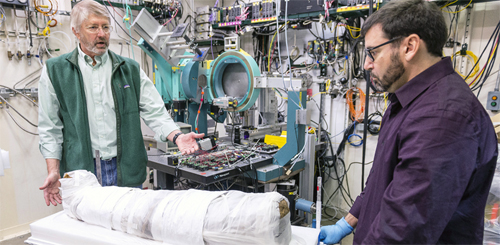
In an interview by Karen Thomas with the International Society for Optics and Photonics (SPIE), APS user Stuart Stock (Northwestern University) discusses how x-ray diffraction reveals details of mummified remains.
Stuart Stock is a research professor of cell and developmental biology at Northwestern University (NU).
In 2018, NU's Block Museum of Art held an exhibit titled "Paint the Eyes Softer: Mummy Portraits from Roman Egypt." These portraits are especially important since few other paintings have survived from the Greco-Roman tradition. The centerpiece of the exhibit was the "Hawara Portrait Mummy Four" — a mummified child buried with a luminous painted portrait. University researchers used computed tomography (CT) to investigate subsurface deterioration and reveal details of the encased body and items within the wrappings.
Stock will be a plenary speaker at SPIE Optics + Photonics where he will cover the provenance of the mummy, what CT tells us about the person and object enclosed, and what secrets x-ray diffraction can reveal.
SPIE: You're known as one the pioneers of x-ray micro-computed tomography (microCT) and position-resolved microbeam x-ray diffraction. Could you describe these technologies and your role in developing them?
Stuart Stock: The first thing to understand is that I am not the person who makes new instruments. Instead, I think of myself as someone who looks at emerging imaging and diffraction technologies and imagines how they might be combined or used to study samples in novel ways. The mummy study described below is an example.
I have been using microCT since 1985, and, in fact, my first paper on the subject was in an SPIE proceedings (X-ray Imaging II, SPIE Vol. 691, 1986). In all forms of (x-ray) CT, one shines x-rays through an object from many different directions. The resulting set of radiographs are then mathematically recombined to give a 3D map of the contents of the object. As the prefix indicates, microCT is a microscopic version of clinical CT scanners.
I have been doing position resolved x-ray diffraction even longer than I have been doing microCT. In x-ray diffraction, a beam of x-rays scatters from the specimen, and crystalline materials reinforce the scattering in certain directions related to the periodicities of the atoms within the crystals. The resulting diffraction pattern is a kind of fingerprint of the material(s) encountered by the beam. In position-resolved x-ray diffraction, one makes a very narrow beam of x-rays, smaller than the diameter of a hair. One scans the beam across the sample and observes the resulting diffraction patterns. Typically, one uses synchrotron x-rays from a storage ring such as the Advanced Photon Source, but people also do this kind of mapping in their home laboratories.
Excerpt © 2021 SPIE
The Advanced Photon Source is a U.S. Department of Energy (DOE) Office of Science User Facility operated for the DOE Office of Science by Argonne National Laboratory under Contract DE-AC02-06CH11357.
The U.S. Department of Energy's APS is one of the world’s most productive x-ray light source facilities. Each year, the APS provides high-brightness x-ray beams to a diverse community of more than 5,000 researchers in materials science, chemistry, condensed matter physics, the life and environmental sciences, and applied research. Researchers using the APS produce over 2,000 publications each year detailing impactful discoveries, and solve more vital biological protein structures than users of any other x-ray light source research facility. APS x-rays are ideally suited for explorations of materials and biological structures; elemental distribution; chemical, magnetic, electronic states; and a wide range of technologically important engineering systems from batteries to fuel injector sprays, all of which are the foundations of our nation’s economic, technological, and physical well-being.
Argonne National Laboratory seeks solutions to pressing national problems in science and technology. The nation's first national laboratory, Argonne conducts leading-edge basic and applied scientific research in virtually every scientific discipline. Argonne researchers work closely with researchers from hundreds of companies, universities, and federal, state and municipal agencies to help them solve their specific problems, advance America's scientific leadership and prepare the nation for a better future. With employees from more than 60 nations, Argonne is managed by UChicago Argonne, LLC, for the U.S. DOE Office of Science.
The U.S. Department of Energy's Office of Science is the single largest supporter of basic research in the physical sciences in the United States and is working to address some of the most pressing challenges of our time. For more information, visit the Office of Science website.
